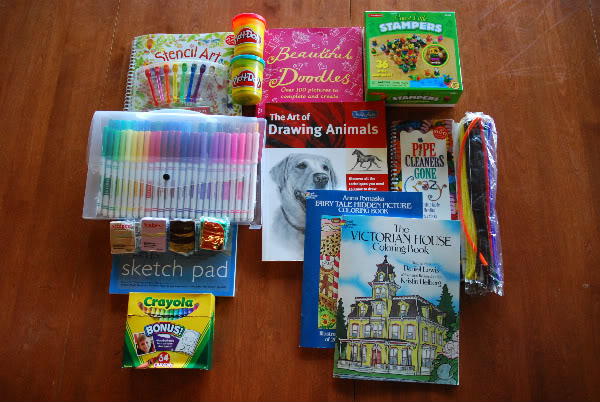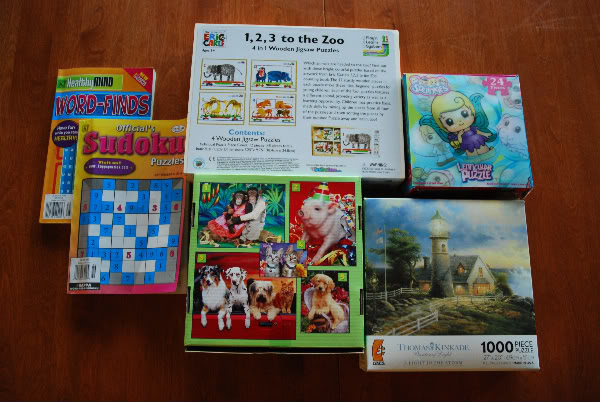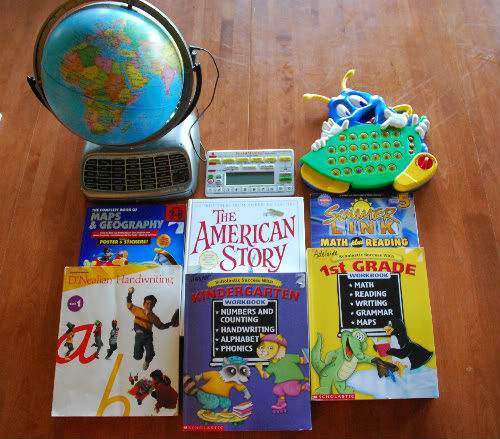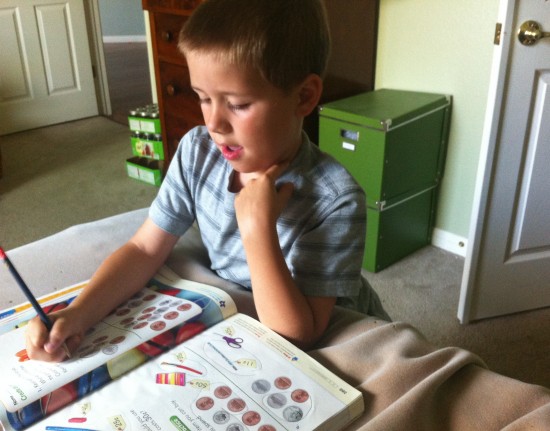This is one of my most popular posts and I like to repost it every year in case you’ve got a houseful of bored (hence, annoying) kids and need to know how to keep them occupied without relying on TVs/vieogames/ipads to babysit them. This is a great way to keep everyone in the house quiet and entertained. It’s really the best thing that’s happened to our summers! We’ve added a few changes to the system as our kids have gotten older. I’ll mention those at the end of the post.
My kids started driving me crazy the day after school got out. There was the constant squabbling, playfighting, and watching each other play video games for hours on end ( I loathe that, but it’s just so peaceful while they do it, that it’s hard to crack down and turn it off). Some people go cold turkey and turn off all screens during the summer, but I think it should still be a fun time of year (especially since we really limit TV and video games during the school year). I just needed to figure out some sort of system.
My friend Amy and I escaped for lunch a few weeks ago. She told me about the system she uses in her house and a giant light bulb went off over my head. I took her idea and ran with it, expanding on it to fit our family’s needs.
This is how it works:
–Our house is divided into six stations (Art, Reading, Computer, Puzzles, Academics, and TV).
–Each station is in a different part of the house (or in separate parts of the same room) so there is very little annoying and teasing of siblings going on.
–Stations last for 45 minutes each (sometimes if we have other plans for the day we’ll only do stations for 20-30 minutes a piece). Then the kids rotate to the next station. Each child goes to all of the six stations every day, Monday through Friday. We usually begin in the late morning after everyone has done their chores. Since we live in Texas which is HOT in the summer, we usually spend the mornings playing outside (after chores!) and don’t waste precious cool time indoors.
–Everyone gets a chance to choose which station they would like to start with. Yes, they will all have a chance at every station, but you know how much siblings like to compete with each other. Currently we are picking popsicle sticks labelled with the kids’ names. I draw one and that child picks where they’d like to begin.
–It’s helpful to have a list of activities available at Academics and art. We have things listed like “work on handwriting”. The kids all tell me they want to improve their handwriting but they forget. Their are workbooks for the littles but the older kids can do it on their own; they just need a reminder. Some of the art things we have are kept in my craft closet and the kids tend to forget about them. Having all the choices on a list makes a good reminder.
Here are the details:
Art (at the kitchen table):
Everyone has a sketch book, so there are minimal amounts of loose paper floating around. All coloring and watercolor go on sketchbook pages. We also have Shrinky Dinks, pipe cleaners, Sculpey clay (for the older kids), Play-Doh (for the younger ones), and brand new sets of watercolors, crayons and markers. I stocked up on the fabulous coloring books that Dover Publishing carries. We also have an assortment of drawing “how-to” books and creativity-building exercises.
Puzzles (on a card table set up in the Mudroom): I bought ten new puzzles of all different skill levels. I also got one of those roll-up puzzle savers so the older kids can work on the same puzzle day after day. We also have Sudoko, crossword, and word-search books of different skill levels. My friend Amy and I will be swapping puzzles after a while to keep things fresh.
Academics (on the coffee table in the family room):
There is a real variety here since Jasper barely knows his letters and India is taking AP classes. Probably our favorite item is the Flashmaster. It’s a fantastic gizmo that quizzes kids on their addition, subtraction, multiplication and division facts. They can be timed or not timed, and the computer remembers which problems they got wrong. It’s been wonderful since my younger kids have never been required to learn their math facts very well. You can get Flashmaster on Amazon for $50.
We also have a Geography Globe from Oregon Scientific, the Phonics Firefly (perfect for helping the younger kids learn their letters and sounds), and some educational Leap Pad sets.
In this category we also have workbooks (the great kind sold at Costco that are full of worksheets), handwriting practice sheets and spelling word quizzes. I try to get items that the kids can do on their own so I don’t have to sit there all day. The older kids are working on assignments they were given at school to complete over the summer.
Reading (in the Living Room which is where our bookcases are):
This is read-alone time. Every few days I rotate the supply of kids’ books so they always have something new to look at. Library books stay in here too. The older kids usually have a novel they’re reading. This is a perfect time for teens to work on their summer reading assignments for school.
Computer (playroom):
The kids can play whatever they want without someone claiming that “she took my turn!”; I don’t really care what it is, whether it’s Webkinz or something educational (Finn has been doing a teach-yourself-German program). This is their entire computer time for the day. This would probably include Nintendo DS time, if you have those at your house.
TV (in the playroom where our only TV is):
This includes video games and DVDs. Whatever takes place on a TV, this is the time to do it. The best part of this system is that you don’t have children sitting around watching their siblings play games (one of my major pet peeves). Occasionally we’ll watch a movie as a family in the evening, but for the most part this is their entire allotment of video games and shows.
You could tailor the stations to suit your family better. If you all play instruments, you could do music time, for example. Or you could do an outdoor station. With our blazing summer temps, though, the kids stay indoors most of the day but we spend evenings playing outside or swimming. This system would work with a smaller family, too. For the last week India and York have been visiting their grandparents in Oregon and we’ve been rotating four kids around the six stations. It’s been fine.
We have been doing Stations for a couple of weeks now and it has been phenomenal! The kids never complain about being bored and they bug each other so much less. My house is actually quiet during the day! It’s a miracle!
UPDATE: now that our kids are getting older, we’ve made a few changes. We’ve combined academics with spiritual stuff. The kids all have goal programs that they’ve been working on at church and this is a great time to accomplish the tasks they’ve set for themselves. We’ve also made a reading plan to for the scriptures this summer and having time during a station for this works a lot better than expecting tired kids to read at night.
We are accumulating a lot of instruments around our house, my new harp being the most popular. So now along with puzzles, we have the option to play an instrument during that station. Not all of the kids are interested in this, though, which is why I didn’t just add another station. My children are finally old enough to use the instruments unsupervised. I would never have done this when I had preschoolers. It would have caused way too much trouble.





LOVE this. Stations!
Flat out fabulous! I’m glad you re-run this every year!
I love stations. I adopted it 2 years ago and it saves me every summer. We only have 2 kids, but 6 stations. It usually takes my kids a few days to get used to it, but then they really enjoy it and even complain when their favorite stations are over. We don’t do TV or computer time as stations, but we do have art, puzzles, education, reading, and church (with church related games and reading). Love the stations!!
When I read this post the first time last year, it totally clicked with me. We just started “stations” this week (since school just got out) for the second year. It is the perfect way for us to give the kids some time apart and also get certain things done (piano practicing) every day. We only have 3 kids and rotate through just three stations (piano, computer time and jounral/art/reading). Really, our kids are just obsessed with having 30 minutes on the computer by themselves, but it motivates them to do the other things, and it helps me be consistent with their practicing. I also love that the system is simple and somewhat flexible. Brilliant!